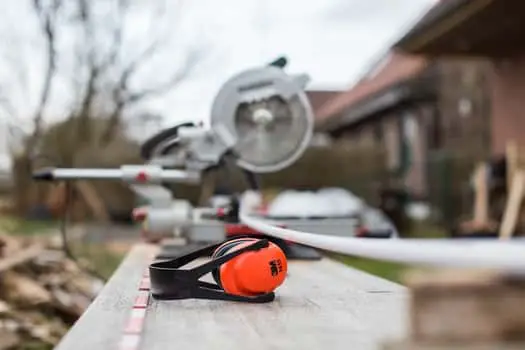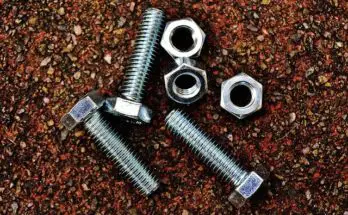Working with wood is often a loud, ear-ringing endeavor. Those boards don’t magically cut themselves in silence, do they? Of course not! To get the job done you use tools—POWER tools! LOUD power tools! Some of the loudest tools in your garage can reach 110 decibels (dB), far beyond what is deemed safe. Which is why having the proper hearing protection is as important as any other woodshop protection.
Why Hearing Protection is Important
Sadly, hearing safety is often overlooked in the woodshop, but it is one of the most common injuries that veteran woodworkers face. In the past thirty years, hearing loss has been one of the most prevalent occupational hazards in the work place.
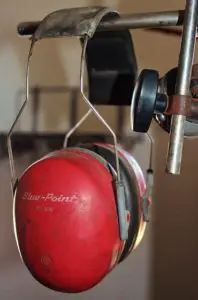
Prolonged exposure to sounds above 85 dB (most power tools give off sounds nearing 100 dB) can cause a myriad of hearing problems. Some may think that hearing damage is an all-or-nothing type of injury—either you can hear, or you cannot—leading many people to address their hearing issues long after the damage has been permanently done. Yet, noise induced hearing loss (NIHL) can come in many different forms.
Woodworkers whom are continuously exposed to dangerously loud sounds might find that they are plagued with a constant ringing in their ears, medically known as tinnitus. Tinnitus affects up to 15% of the population, many of whom have had exposure to damagingly loud noises at work. Even though tinnitus is not always caused by exposure to loud sounds (it can also be caused by infections, dental issues, etc.) it is most definitely exasperated by exposure to sounds above 85 dB or even continued exposure to marginally loud sounds.
Sufferers of tinnitus have sometimes had difficulty sleeping, remaining focused, or hearing people speak. Extreme cases have shown those with tinnitus to also have significant difficulty hearing external noises, while others may even suffer from depression. Thankfully, there are remedies to lessen the extent of one’s tinnitus. A doctor may prescribe medicine or the assistance of a hearing aid. Most suffers make changes to their lifestyle (e.g. avoid loud sounds) in order to reduce the chances of worsening their tinnitus.
Aside from a constant ringing in the ears, woodworkers may even face partial or complete hearing loss! Sadly, this is far more common than it may seem. According to The Center for Hearing and Communication, up to 35 million people have noticeable hearing loss—many of whom could have prevented it had they taken the proper steps to protect themselves from loud noises. Hearing loss can be helped with the assistance of hearing aids, but there is no surgery or medication that can actually repair the parts of the eardrum that are damaged when loud sounds are present.
Significant hearing loss happens so much more often than it should because it goes ignored. It falls into a category called ‘invisible injuries’ because there are very few outward signs of a problem, until it is too late. According to OSHA, any sound above 85db’s calls for hearing protection, with table saws and routers easily reach 100dBs and a handheld circular saw top110 dbs. So anytime we use these tools without proper protection, we put ourselves at risk for permanent hearing loss. The scary part is that many shopworkers do not realize the extent of their hearing loss until a formal screening has been completed. This is because of the fact that as their ability to hear diminishes, so does their sensitivity to the loud sounds they surround themselves with. In short, the less they can hear the less they realize how much damage is being done to their hearing.
History of Hearing Protection
Loud sounds have been around since the dawn of time. However, other than putting a finger or foreign object in the ear canal, there were not many options in terms of protecting one’s hearing. Hearing protection was first taken seriously during the 19th century when the military took it upon themselves to protect the ears of the soldiers whom were exposed to the deafening sounds of battle.

The industrial revolution of the late 1800’s brought with it the earsplitting sounds of machinery, which in turn led to the roar of car engines, the pop of machine guns, and the thunder of tanks and biplanes. Earplugs were patented and implanted during World War I, but it was not until the V-51R earplugs were introduced during World War II did we see them become more commonplace. As military weapons and technology continued to advanced, it of course also continued to become louder.
The leather padded ear flaps on leather flying helmets were designed to reduce the pilot’s exposure the roar of the plane engine. This led to the creation of ear muff style hearing protection, which soon advanced in its comfortability as well as electronic capabilities. Headband style hearing protection had been used as early as the 19th century as well, but became increasingly more popular in the 60’s and 70’s due to their comfortability and user-friendliness.
Even the simple design of WWII earplugs advanced a great deal over the course of a century. Once made of just wax, rubber and plastic models were introduced and then foam and silicone options became available as hearing protection science advanced.
All in all, a great deal of science and technology has gone into protecting our hearing, and even though most forms of hearing protection were first implemented for military purposes, factory and construction workers soon caught on as well.
In 1971, OSHA implemented Noise Exposure Regulations in the work place. A few years later the Hearing Conservation Amendment of 1983 included an amendment to require specific components related to hearing protection, audiometric testing, and training. OSHA’s approach of ‘remove the hazard or remove the worker’ led to dramatic changes in the workplace. In doing so, OSHA spurred on a growing concern for the prevention of hearing loss amongst workers as well as the interest of scientists and hearing experts. In turn, the market for hearing protection also grew.
Common Types of Hearing Protection
Thankfully, hearing loss and/or damage is 100% preventable. Like any job in the workshop, it is all about using the right tools. In this case, protecting our hearing requires using the right combination of equipment.
The most common and probably the most effective type of ear protection is of the ear muff variety. Many noise reducing ear muffs can subtract nearly 30 dBs from the sound of the shop, lowering the deafening sounds of even the loudest power tools to a safe level.
For example, the Peltor Optime 105 muff style hearing protectors are a favorite among woodworkers and come with a Noise Reduction Rating (NRR) of 29. When working in a loud shop for extended periods of time, that type of protection can be the difference between long-lasting and effective hearing, and possibly significant hearing loss.
Now, hearing protection has been around for centuries, but companies have recently improved upon earlier designs in order to make them more comfortable, sophisticated, and enjoyable to wear. When shopping for muff style hearing protection you will likely find that nearly all of them have adjustable head bands, an ergonomic design, and cushioning at all contact points. Yet, others have added luxuries. Woodworkers can now purchase noise reducing ear muffs with AM/FM capabilities. Others have even added MP3 and Bluetooth options, increasing a woodworker’s listening possibilities.
3M is a name that you are going to hear often when shopping for hearing protection, and even though they 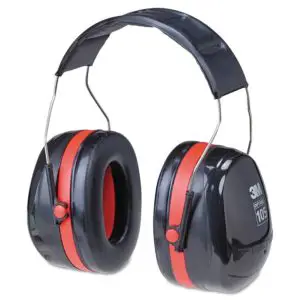 make everything from sandpaper to office supplies, some of their best work has been with ear muff hearing protectors. Best of all, 3M makes a number of different models to meet very specific needs. For example, the 3M Peltor ProTac III is equipped with external microphones allowing the listener to still hear the sounds of the tools but regulated well below 85dB. So, one can still listen to their music, baseball game, or talk radio program while also still hearing the swoosh of the block plainer or the pop of the brad nailer—all within the recommended listening range.
make everything from sandpaper to office supplies, some of their best work has been with ear muff hearing protectors. Best of all, 3M makes a number of different models to meet very specific needs. For example, the 3M Peltor ProTac III is equipped with external microphones allowing the listener to still hear the sounds of the tools but regulated well below 85dB. So, one can still listen to their music, baseball game, or talk radio program while also still hearing the swoosh of the block plainer or the pop of the brad nailer—all within the recommended listening range.
Your run of the mill ear plugs were once the most common form of ear protection while in the shop. Small, cheap, and replaceable were once the ideal attributes of product designed to assist in what was once a secondary concern. However, ear plugs have evolved a great deal in the last few decades.
One can still purchase the standard foam ear plugs, and many of them are quite effective. Most, when applied properly, are made of memory foam and will expand to fit the contour of the ear canal. This is ideal when attempting to reduce the amount of sound capable of reaching the fragile components of our ear drums. However, they are indiscriminate in their sound blocking and make it difficult to hear the sounds of tools. They can also be uncomfortable, creating a feeling of pressure and even AMPLIFYING internal sounds!
Known as the occlusion affect, sound that would normally exit the ear (such as the vibrating of bones of cartilage) are now unable to do so. The occlusion effect does not offer any additional possibilities for harm, but it is a common nuisance.
Other ear plugs are bit more advanced. Some silicone models are reusable and have a flanged design, allowing for certain sounds to pass through while blocking others. Surefire is a company that prides itself on the versatility of their flanged ear plugs. Their EP5 SONIC DEFENDERS double-flanged-stem design fits most people and provides an NRR of 24dB. Sounds at lower, safer levels are allowed to pass through into the ear canal, while potentially harmful noises above 85dB are greatly reduced by way of a special noise-reducing filter. Such models are much more expensive than disposable ear plugs, but because they are made of silicone they can be washed and reused time and time again.
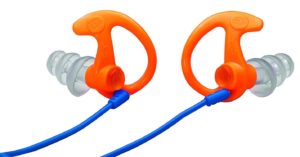
Other companies offer moldable ear plugs. This design is one of the oldest, harkening back to when woodworkers would roll up beeswax and place it in their ear canals (gross!). Nowadays, these plugs are made of moldable silicone and are reusable. Moldable ear plugs are great in terms of comfort and price, however many of them are less effective than their foam and flanged counterparts. They of course can be used in the workshop or any other environment with exposure to loud noises, but there are more effective options available.
Headband style ear plugs are far more advanced than the disposable type. In a way, they are sort of hybrid between the ear muffs and the ear plugs. Rather than covering your entire ear, they fit snuggly into the ear canal, providing a tight yet comfortable fit. Instead of each plug existing freely or connected by string, they are part of a single head band, which is normally lightweight and can be comfortably worn around the neck until they are needed. Much like the ear muffs, these headbands come with a variety of luxuries if you are willing to spend the money.
Most of them are designed for comfort, with ergonomic designs and padding at all points where the headband will contact your head. Others have radio and Bluetooth capabilities, allowing a woodworker the option to listen to his or her favorite baseball game or podcast while toiling away on their latest project. They are typically much more comfortable than muff style hearing protection, especially in hot and sweaty environments. However, most of them do not have the same NRR that ear muffs and high-end ear plugs offer. Even worse, they are difficult to pair with other forms of hearing protection.
The Best Way to Protect Your Hearing
The truth of the matter is that all of these hearing protection options are effective when worn properly. However, nothing is more effective than dual protection. Dual protection (as the name alludes) is the combination of two different forms of hearing protection in order to maximize hearing safety.
Probably the most effective and comfortable combinations would be high-end ear plugs coupled with the right ear muffs. Pressed snuggly against the user’s heard, the ear muffs surround the entire ear, greatly reducing the amount of sound reaching the ear, while the ear plugs offer a second line of defense. Having the entire ear covered while having the ear canal protected from loud, damaging sound waves is the ideal combination in hearing protection.
Even better, if one were to purchase top of the line ear plugs, such as the Moldex Pura-Fit (which carry a heafy NRR of 33 db!), and combine them with a pair of ear muffs with external speakers such as the ClearArmor 141001 Safety Ear Muffs (with 34 NRR dB!) the user would have maximum protection. In terms of how MUCH protection, experts have proven that adding two forms of hearing protection together can add up to 5 more dB to the device with the higher NRR. So, in our example, the ear plug/ear muff combo would offer an NRR of 39 dB—making even the loudest environments much safer. The worker could also choose to go with an ear muff design that comes equipped with external microphones.
This would allow the worker to choose ear plugs that have a very high NRR, but still allow for the possibility to hear the tools in use. In short, there are several ways in which a woodworker can combine hearing protectors. Dual protection is the recommendation of experts as well as veteran woodworkers, but having at least one form is protections is absolutely necessary. Safety is as important as knowledge and experience in the woodshop, and your ears should not go unprotected.
In Conclusion…
All in all, hearing dangers in the woodshop are not taken as seriously as the should be, but all forms of noise induced hearing loss are preventable if the proper protection is implemented. Such concerns are not new, and
![Your Best Digs [<a href="https://creativecommons.org/licenses/by/2.0">CC BY 2.0 </a>], <a href="https://commons.wikimedia.org/wiki/File:Types_of_Earplugs.jpg">via Wikimedia Commons</a>](https://www.makefromwood.com/wp-content/uploads/2018/08/256px-Types_of_Earplugs.jpg)
Truthfully, hearing loss is not taken as seriously as other hazards. The invisible injury still plagues workers across the world, and without a proactive approach tinnitus and hearing loss will haunt thousands of others. Everything from ear plugs designed to filter out only dangerously loud noises to ear muffs with blue tooth technology and external microphones are available. Woodworkers need to remember that hearing injuries are 100% preventable, especially if one uses dual hearing protection. It should be routine to put in ear plugs every time you wear your safety glasses and shop apron.

